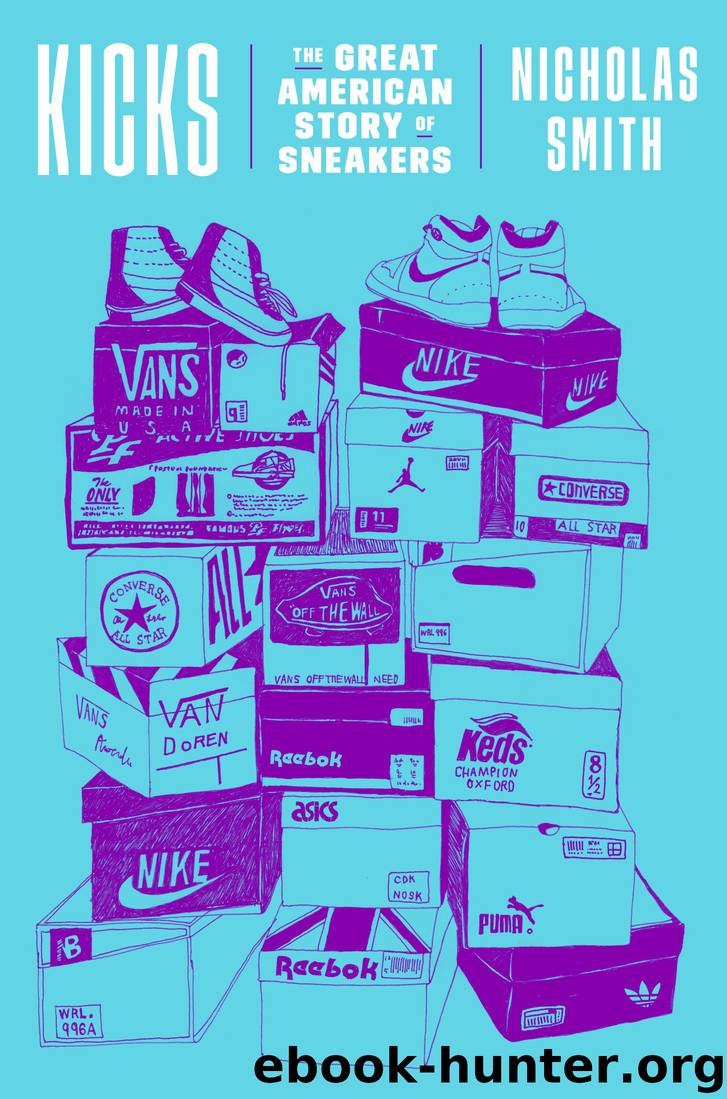Kicks by Nicholas Smith

Author:Nicholas Smith
Language: eng
Format: epub
Publisher: Crown/Archetype
Published: 2018-05-01T04:00:00+00:00
* * *
—
An African American doctor named Gerald W. Deas makes one of the unlikeliest cameo appearances in sneaker history. Besides his day job as an internist at Jamaica Hospital Medical Center in Queens, Deas wrote plays, poems, and songs revolving around social ills. His play tackling poor diets, titled Oh! Oh! Obesity!, was staged on Manhattan’s Lower East Side in 1984. In 1985, the same year the FDA gave Dr. Deas an award for his advocacy of nutrition labeling, a poem of his was turned into a rap song. “Felon Sneakers” was Deas’s take on what he saw as the troubling trend of kids wearing sneakers without laces, as prison inmates did. One couplet read, “You shoot and kill / You wearing those sneakers but you lost your will.” Deas felt that imitating the way inmates wore shoes would hold young black men back. That caught the attention of a hip-hop group called Run-DMC, who didn’t like anyone slighting the way they wore their Adidas Superstars.
By the mid-1980s, hip-hop had moved on from DJ-centric outdoor parties and jams as the music itself focused more on the MC aspect than the man behind the turntable. Grandmaster Flash saw the shift early and enlisted not one but five MCs to rap over his beats. Grandmaster Flash and the Furious Five, along with the rival group Cold Crush Brothers, transitioned hip-hop to performances that were more concerts than neighborhood dance-a-thons.
Hip-hop groups started to appear in trendy Manhattan clubs and to sign record deals. In 1982, Afrika Bambaataa & Soulsonic Force released the electro-funk single “Planet Rock,” influenced by the German electronic band Kraftwerk, James Brown, and Sly and the Family Stone. The Zulu Nation founder performed in spacy costumes that resembled a meld of Flash Gordon and Funkadelic. That same year, Grandmaster Flash and the Furious Five released the influential hit “The Message,” which painted a bleak, realistic portrait of inner-city poverty to the refrain “It’s like a jungle sometimes / It makes me wonder how I keep from going under.” (DJ Kool Herc, the third member of the “Holy Trinity,” by then had faded from the scene.)
Run-DMC marked another chapter in hip-hop’s evolution. The rhymes of the trio’s two MCs, Joseph “Run” Simmons and Darryl “DMC” McDaniels, were harder and more rock-oriented than those of other acts, and the group’s DJ, Jason “Jam Master Jay” Mizell, relied on drum effects and scratching rather than the disco-adapted samples favored by the genre’s pioneers. As with “The Message,” Run-DMC sang about the world around them. “Unemployment at a record high / People coming, people going, people born to die,” the two MCs sang on their debut 1983 single “It’s Like That.”
Their stripped-down sound was what one might actually hear on the street, not produced in a studio with expensive equipment. This went for their look, too: after dropping their original geeky plaid outfits, Run-DMC adopted leather jackets, black velour hats, Adidas track suits, and gold chains—something fans might see on their native
Download
This site does not store any files on its server. We only index and link to content provided by other sites. Please contact the content providers to delete copyright contents if any and email us, we'll remove relevant links or contents immediately.
| Automotive | Engineering |
| Transportation |
Whiskies Galore by Ian Buxton(41525)
Introduction to Aircraft Design (Cambridge Aerospace Series) by John P. Fielding(32885)
Small Unmanned Fixed-wing Aircraft Design by Andrew J. Keane Andras Sobester James P. Scanlan & András Sóbester & James P. Scanlan(32569)
Craft Beer for the Homebrewer by Michael Agnew(17928)
Turbulence by E. J. Noyes(7694)
The Complete Stick Figure Physics Tutorials by Allen Sarah(7135)
Kaplan MCAT General Chemistry Review by Kaplan(6591)
The Thirst by Nesbo Jo(6432)
Bad Blood by John Carreyrou(6271)
Modelling of Convective Heat and Mass Transfer in Rotating Flows by Igor V. Shevchuk(6219)
Learning SQL by Alan Beaulieu(6029)
Weapons of Math Destruction by Cathy O'Neil(5824)
Man-made Catastrophes and Risk Information Concealment by Dmitry Chernov & Didier Sornette(5643)
Digital Minimalism by Cal Newport;(5388)
Life 3.0: Being Human in the Age of Artificial Intelligence by Tegmark Max(5182)
iGen by Jean M. Twenge(5158)
Secrets of Antigravity Propulsion: Tesla, UFOs, and Classified Aerospace Technology by Ph.D. Paul A. Laviolette(4980)
Design of Trajectory Optimization Approach for Space Maneuver Vehicle Skip Entry Problems by Runqi Chai & Al Savvaris & Antonios Tsourdos & Senchun Chai(4837)
Electronic Devices & Circuits by Jacob Millman & Christos C. Halkias(4741)
